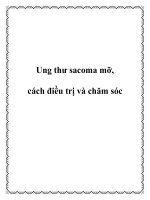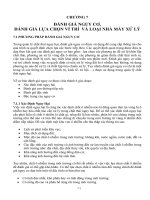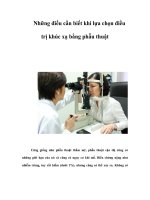Gãy xương cấp tính: Lựa chọn điều trị và kết quả docx
Bạn đang xem bản rút gọn của tài liệu. Xem và tải ngay bản đầy đủ của tài liệu tại đây (136.9 KB, 8 trang )
36 Journal of the American Academy of Orthopaedic Surgeons
Acute Calcaneal Fractures:
Treatment Options and Results
Lance R. Macey, MD, Stephen K. Benirschke, MD, Bruce J. Sangeorzan, MD,
and Sigvard T. Hansen, Jr, MD
The calcaneus is the most commonly
fractured tarsal bone. Despite the
orthopaedic community’s length of
experience with this injury, treat-
ment remains a source of contro-
versy. Historically, the treatment of
acute calcaneal fractures has been
largely dissatisfying due to the mar-
ginal functional results. In 1916 Cot-
ton and Henderson, writing on the
basis of their experience with con-
servative treatment, stated that “the
man who breaks his heel bone is
done.” This view was reiterated by
Conn, who in 1926 reported that
“calcaneus fractures are serious and
disabling injuries in which the end
results continue to be incredibly
bad.” In 1942 Bankart’s experience
was summarized when he wrote,
“the results of crush fractures of the
os calcis are rotten.”
1
The search for improved results
has provided a strong impetus for
the development of alternative treat-
ment methods. Historically, a wide
spectrum of treatment options have
been advocated. Elevation, compres-
sion, and early range-of-motion
exercises without reduction were
supported by Rowe et al.
2
Gissane
and Bohler advocated closed manip-
ulative reduction by means of percu-
taneous pins placed in the tibia and
calcaneus, followed by casting.
3
Gal-
lie
4
and Hall and Pennal
5
reported
their results with primary arthrode-
sis as the treatment of choice for
severely comminuted os calcis frac-
tures. Recently, open reduction with
rigid internal fixation has gained
increasing support.
The lack of consensus regarding
the most appropriate treatment of
calcaneal fractures has resulted in
part because the association between
classification and treatment has not
been consistent. Clearly, a meaning-
ful classification scheme must
include information relative to pat-
tern of injury, prognosis, and treat-
ment. Several authors have proposed
schemes based on fracture configura-
tion and the degree of involvement
of the posterior facet,
1,6-8
but the prog-
nostic value of these schemes has
been variable. Consequently, there is
no single method of classification
that has gained universal acceptance
or that reliably addresses these
issues.
For the purpose of data collection,
we use the classification system
described by Letournel.
6
This system
is based on the premise that all dis-
placed calcaneal fractures have one
fracture line in common, the separa-
tion fracture (the primary fracture
line). This fracture line runs
obliquely anterior to posterior,
breaking the calcaneus into two
pieces through the sinus tarsi or the
posterior facet, and always lies
behind the interosseous ligament.
An essential feature of this fracture
line is that it creates a fragment (the
sustentaculum tali) that remains
attached to the talus by the
interosseous ligament. The simplest
displaced fractures end with this line
and are considered two-part frac-
tures (Fig. 1). These are extremely
rare injuries, as the associated
trauma usually creates secondary
fracture lines that extend through-
out the remainder of the calcaneus.
Dr. Macey is Attending Orthopaedic Surgeon,
St. Joseph Hospital and Nashua Memorial Hos-
pital, Nashua, NH; and Attending Orthopaedic
Surgeon, Parkland Medical Center, London-
derry, NH. Dr. Benirschke is Associate Professor,
Department of Orthopaedic Surgery, University
of Washington, Harborview Medical Center,
Seattle. Dr. Sangeorzan is Associate Professor,
Department of Orthopaedic Surgery, University
of Washington, Harborview Medical Center. Dr.
Hansen is Professor, Department of Orthopaedic
Surgery, University of Washington, Harborview
Medical Center.
Reprint requests: Dr. Macey, 29 Riverside Drive,
Nashua, NH 03062.
Copyright 1994 by the American Academy of
Orthopaedic Surgeons.
Abstract
The treatment of choice for acute displaced intra-articular calcaneal fractures
remains controversial. The authors present a brief historical review of treatment
options and results, coupled with the biomechanical rationale for open reduction
and internal fixation. Their current management protocol and surgical technique
are outlined, along with preliminary functional results at an average follow-up of
2.5 years.
J Am Acad Orthop Surg 1994;2:36-43
In a simple three-part fracture,
there is an additional fracture line
through the posterior facet. If this
fracture line involves only the poste-
rior facet without extension into the
tuberosity, it is considered an
impaction fracture or a joint-depres-
sion fracture (Fig. 2). In a tongue-type
fracture, the fracture line continues
posteriorly to include the posterior
facet and exits through the posterior
aspect of the tuberosity (Fig. 3). In the
simplest fractures, the inferior cortex
of the calcaneus remains intact,
thereby preserving the general mor-
phologic features of the bone.
Complex fractures result in four
or more fragments. These include
the two basic fragments from the pri-
mary fracture line and the posterior
facet fragment in combination with
other fragments created by sec-
ondary fracture lines that extend
through the inferior cortex and the
anterior process of the calcaneus.
These fractures disrupt the whole
morphologic structure of the bone
and are associated with severe dis-
ruption of the lateral cortex caused
by violent impaction of the posterior
facet (Fig. 4).
Although we use Letournel’s
classification system for descriptive
purposes, we do not consider this
system comprehensive enough to
serve as the only basis for a decision
to proceed with operative interven-
tion. We believe an important crite-
rion is restoration of biomechanical
function.
Biomechanical Rationale
for Open Reduction
An evaluation of normal hindfoot
function provides the most com-
pelling evidence in support of
anatomic reduction of calcaneal frac-
tures. Because the majority of cal-
caneal fractures involve the
talocalcaneal articulation, a good
understanding of subtalar joint func-
tion is important in comprehending
the rationale for anatomic reduction.
Further support for anatomic
restoration comes from an under-
standing of the relationship between
normal calcaneal morphology and
hindfoot function during normal
gait.
Subtalar Joint Function
One important function of the
subtalar joint is its action as a torque
converter producing a cushioning
effect on the foot. During normal
gait, between the phases of “heel
strike” and “foot flat,” the subtalar
joint converts the normal internal
Vol 2, No 1, Jan/Feb 1994 37
Lance R. Macey, MD, et al
Fig. 1 Constant separation fracture line. A, Fracture runs through the sinus tarsi behind the
interosseous ligament. B, Fracture intersects the thalamus (posterior facet). C, Two-fragment
fracture without displacement (exceptional).
A
B
C
Fig. 2 Three-fragment fractures. A, Impaction
of the thalamus; the various fracture lines are
seen from above. B, Horizontal impaction of
the thalamus. C, Possible fracture lines of a ver-
tical impaction. D, Vertical impaction of the
thalamus.
B
C
D
A
rotation of the tibia into pronation of
the foot by increasing the talocal-
caneal angle (producing hindfoot
valgus) and unlocking the trans-
verse tarsal joints. This torque con-
version results in a softening of the
arch, allowing shock absorption
because the arch functions as a leaf
spring (Fig. 5). Between the phases
of “foot flat” and “toe off,” normal
external rotation of the tibia causes
convergence of the talocalcaneal
angle (producing hindfoot varus),
which locks the transverse tarsal
joints and creates a more rigid plat-
form for push-off.
9,10
The second important function of
the subtalar joint is to allow the foot
to adapt to uneven surfaces through
inversion and eversion. These
actions protect the tibiotalar joint,
where motion is normally limited to
the sagittal plane. Without free sub-
talar inversion and eversion, the
tibiotalar joint is exposed to unusu-
ally high stresses out of its normal
plane of motion. Long-term studies
of subtalar and triple arthrodeses
have shown that significant degen-
erative changes occur in the ankle
when the subtalar joint is unable to
cushion and protect the ankle from
medial and lateral tilt stresses.
11
Calcaneal Function
Normal calcaneal morphology
contributes to three principal func-
tions of normal gait, which are vari-
ably disrupted dependent on the
fracture pattern:
1. The normal calcaneus provides
a lever arm to increase the power of
the gastrosoleus mechanism. This
lever arm is extended through the
midfoot and forefoot by normal sub-
talar supination with simultaneous
locking of the transverse tarsal artic-
ulations. To maximize the efficiency
of its lever-arm function, the calca-
neus must provide a fulcrum in the
midbody of the talus, and it must
interact normally with its motor, the
gastrosoleus muscle. High-energy
calcaneal fractures markedly disrupt
these anatomic relationships and
have a profound effect on hindfoot
function. The gastrosoleus muscle is
functionally weakened when the
subtalar joint is disrupted and the
tuberosity of the calcaneus is dis-
placed proximally.
2. Normal calcaneal structure
provides a foundation for body
38 Journal of the American Academy of Orthopaedic Surgeons
Acute Calcaneal Fractures
Fig. 4 Complex calcaneal fractures comprising four fragments or more. A, Fracture lines on
the upper aspect of the bone. B, Axial view of fracture. C, Lateral view of a complex fracture.
A
B
C
Fig. 5 The osseous and ligamentous struc-
tures of the foot soften the arch when the
tibia is internally rotated and locked onto
the dome of the talus. Pronation occurs at
the beginning of the weight-bearing portion
of the gait cycle as the foot strikes the
ground and accepts body weight. The foot
rotates laterally under and in front of the
talus, and as a result the arch of the foot
functions as a leaf spring.
Fig. 3 Tongue-type fracture vertical
impaction of the thalamus. A, Lateral view.
B, Axial view of the tongue.
A
B
weight transmitted through the tibia,
ankle, and subtalar joints. The nor-
mal vertical-support function of the
calcaneus is dependent on its normal
alignment beneath the weight-bear-
ing line of the tibia to prevent eccen-
tric weight distribution in the foot.
Lateral displacement of the calca-
neus may result in fibular or per-
oneal impingement. In addition,
eccentric weight-bearing may cause
a valgus tilt of the hindfoot, resulting
in increased stresses on medial soft-
tissue structures (deltoid ligament
and posterior tibialis muscle). Medial
displacement of the body of the os
calcis results in varus alignment,
causing increased compressive
forces on the medial aspect of the
ankle and increased tension on the
lateral soft-tissue structures (lateral
ligaments and peroneal muscles).
This deformity may predispose to
lateral ankle sprain and eventually
lead to varus tilting of the talus and
secondary ankle arthrosis. Direct
vertical collapse of the calcaneus
results in impaction of the talus into
the body of the calcaneus. The talus
then assumes a more dorsiflexed
position in the ankle mortise, which
can result in anterior ankle impinge-
ment, decreased ankle dorsiflexion,
and accelerated arthrosis.
3. Normal calcaneal anatomy
provides structural support for the
maintenance of normal lateral col-
umn length, which affects abduction
and adduction of the midfoot and
forefoot. In addition, lateral support
indirectly assists in supination of the
foot to provide strong push-off dur-
ing gait. When the anterior process
of the calcaneus is fractured, often
there is shortening and loss of lateral
column length. As a result, the mid-
foot and forefoot are forced into
abduction through Chopart’s joint,
the naviculocuneiform joint, or Lis-
franc’s joint. Abduction leads to
increased tension on the posterior
tibial tendon and may lead to lateral
peritalar subluxation or frank dislo-
cation with posterior tibial tendon
rupture. As the calcaneus continues
to migrate laterally, there may be
talocalcaneal impingement in the
sinus tarsi. This degree of malalign-
ment causes severe compromise in
the vertical-support function of the
calcaneus.
Criteria and Goals for Surgery
The important relationships
between the calcaneus and normal
hindfoot function underlie the bio-
mechanical rationale for the surgical
restoration of normal calcaneal
anatomy. Absolute indications for
operative fixation have not been
determined and will vary among
orthopaedists. The important crite-
ria we consider in our decision to
pursue operative intervention
include: (1) the degree of distortion
in the relationship between the pos-
terior facet and the middle and ante-
rior facets, which may contribute to
the development of restricted subta-
lar motion; (2) the amount of dis-
placement within the posterior facet;
(3) the amount of lateralization of
the tuberosity; and (4) the degree of
widening of the foot and other fac-
tors such as displacement of the
tuberosity and/or calcaneocuboid
joints.
The goal of surgery should be to
restore normal calcaneal morphol-
ogy and regain the normal height,
width, length, and longitudinal axis
of the calcaneus, with stable
anatomic reconstruction of all joint
surfaces to allow early motion. Cal-
caneal body fractures that do not
change the weight-bearing surface
of the foot or alter normal hindfoot
mechanics usually receive closed
treatment. In a simple fracture pat-
tern with only a primary fracture
line extending through the posterior
facet, 2 mm of displacement may be
tolerated and closed reduction can
be used. We believe that fractures
with displacement of 3 mm or more
should be treated with open reduc-
tion and internal fixation. We believe
there is no fracture too comminuted
for reduction, because the salvage
for a severely comminuted, mal-
united fracture is usually more
difficult than the initial fracture
surgery.
We try to reconstruct all fractures
within 10 days from the time of
injury if soft-tissue conditions are
favorable. Reduction becomes very
difficult after 3 weeks.
Preoperative Evaluation
and Treatment
Displaced intra-articular fractures
of the calcaneus are the result of
high-energy axial-loading injuries.
Consequently, the damage to the
surrounding soft-tissue envelope
may be extensive, resulting in
significant swelling. Fracture-blister
formation is common. To minimize
soft-tissue compromise during the
preoperative period, the foot should
be elevated to the level of the heart
and immediately splinted with the
ankle in neutral position. Surgical
timing is dependent on the condi-
tion of the soft tissues. Swelling
should be decreased such that tissue
turgor allows skin wrinkling in
response to gentle pressure. Frac-
ture blisters should be debrided and
allowed to epithelialize prior to sur-
gical reconstruction.
Understanding the fracture pat-
tern is dependent on the appropriate
radiographic evaluation. Preopera-
tive lateral and axial plain films are
essential for the preliminary investi-
gation of the fracture type. In addi-
tion, transverse (parallel to the
plantar surface) and coronal (per-
pendicular to the posterior facet)
computed tomographic (CT) scans
should be obtained to evaluate the
fracture pattern and degree of com-
minution. The CT scans should be
evaluated to determine the degree of
widening of the heel and the amount
Vol 2, No 1, Jan/Feb 1994 39
Lance R. Macey, MD, et al
of hindfoot varus, calcaneocuboid
disruption, anterior process injury,
and posterior facet involvement. We
have found no real advantage to
three-dimensional CT scans in pre-
operative planning.
Operative Technique
The goal of surgery is anatomic
reduction of the calcaneus and rigid
internal fixation so that early motion
can proceed. Restoration of the artic-
ular surfaces, overall shape, and
alignment of the calcaneus is critical
to achieve successful functional
results.
Historically, the specific surgical
approach for reduction has been the
source of controversy in the treat-
ment of these injuries. The medial
approach has been advocated by
McReynolds.
12
The benefits of this
approach include good visualization
of the sustentaculum tali and the
ability to control varus and valgus
alignment. The disadvantages
include poor visualization of the
posterior facet and lateral wall and
the lack of exposure of the calca-
neocuboid articulation.
The lateral approach to the calca-
neus has been favored by Palmer
13
and Letournel
6
and has been
modified by Benirschke.
14
This
approach is our method of choice for
treating displaced intra-articular cal-
caneal fractures. The advantages
include excellent exposure of the
tuberosity, posterior facet, lateral
wall, and calcaneocuboid articula-
tion. Reduction of the sustentaculum
to the tuberosity through the lateral
approach is performed indirectly.
Stephenson
15
advocates a com-
bined lateral and medial approach to
difficult fractures. This method
offers the advantages of both
approaches; however it requires
substantial soft-tissue stripping and
disruption of the calcaneal blood
supply.
To perform a lateral approach, the
patient is placed on the operating
table in the true lateral position. The
extremity is exsanguinated, and a
pneumatic tourniquet is used for
hemostasis. After identification of
the important superficial landmarks,
including the fibula, the Achilles ten-
don, and the base of the fifth
metatarsal, a J-shaped (left side) or
L-shaped (right side) incision is
made laterally (Fig. 6) with care to
avoid injury to the sural nerve. The
incision should extend directly to
bone plantar to the peroneal tendons
to allow the development of a full-
thickness periosteal-cutaneous flap.
The calcaneofibular ligament and
peroneal tendon sheaths are sharply
dissected off the lateral wall of the
calcaneus and maintained within the
flap. Progressive dorsally directed
dissection results in a full view of the
tuberosity, subtalar joint, and ante-
rior process. Two small K wires can
be placed into the lateral aspect of
the talus to serve as soft-tissue
retractors of the flap. Distal exten-
sion of the incision with dissection
over the peroneal tendons may be
necessary to fully visualize the calca-
neocuboid joint.
Once adequate exposure has been
obtained, the blown-out portion of
the lateral wall is removed and
marked to preserve its orientation.
The posterior facet is then disim-
pacted from the body of the calca-
neus and inspected to document the
extent of comminution and articular
cartilage disruption. If the posterior
facet is comminuted, it should be
anatomically reconstructed on the
back table using 0.045-inch K wires.
We have found that many intra-
articular fractures have associated
extension into the anterior process.
In this situation, the first step is to
reduce the sustentacular fragment to
the anterior process at the critical
angle of Gissane. This reduction is
provisionally held with 0.045-inch K
wires.
Next, attention is turned to reduc-
ing the posterior facet to the anterior
process–sustentaculum complex.
Again, K wires are used for provi-
sional fixation. The tuberosity is then
indirectly reduced to the sustentacu-
lar complex and the medial wall
with the use of a 4.0- or 5.0-mm
Schanz pin introduced laterally into
the tuberosity. The Schanz pin is
used to manipulate the tuberosity
and secure anatomic alignment in
the varus-valgus planes (Fig. 7). This
reduction is provisionally held with
0.062-inch K wires directed axially.
Alignment and reduction are
then confirmed with intraoperative
lateral and axial radiographs. Bone
defects are filled with cancellous
graft. The lateral wall is replaced,
and a 3.5- or 2.7-mm reconstruction
plate is contoured to span from the
tuberosity to the anterior process lat-
erally. The plate is fixed with 3.5- or
2.7-mm screws. Two additional 3.5-
mm thalamic lag screws are placed
beneath the articular surface of the
posterior facet to maintain the
reduction of the posterior facet to the
sustentacular fragment (Fig. 8).
Additional fixation of the posterior
tuberosity is often necessary if a
tongue component exists. This is
best accomplished with a small or
medium cervical H plate placed
under the reconstruction plate and
extending over the dorsal aspect of
40 Journal of the American Academy of Orthopaedic Surgeons
Acute Calcaneal Fractures
Fig. 6 Surgical approach (dashed line).
Sural nerve (solid lines) is shown just above
it within the elevated periosteal-cutaneous
flap.
the tuberosity. All provisional
fixation is then removed. In areas not
suited for screw fixation, such as the
anterior process at the critical angle
of Gissane, K wires are left in,
impacted next to the plate.
The wound is closed over a
1
⁄8-inch
suction drain brought out dorsolat-
erally through the skin overlying the
sinus tarsi. The drain is routinely
removed 48 hours after the opera-
tion. The periosteal-cutaneous flap is
closed as a single layer using 2-0
Vicryl in an inverted, interrupted
fashion. The skin is closed using a 3-
0 nylon horizontal stitch to minimize
tension on the edge of the flap.
Postoperative Care
Initially, the leg is splinted with the
ankle in neutral position for 72 hours
and then placed in a removable alu-
minum splint with a sheepskin lin-
ing. When the incision is dry (3 to 5
days), an active ankle and subtalar
range-of-motion exercise program is
begun. The exercise program also
includes passive stretching of all
toes to avoid the development of
flexion contractures. Sutures are
removed at 3 weeks, and patients
avoid weight-bearing for 12 weeks
postoperatively. Patients are fitted
with support stockings to control
edema and are encouraged to con-
tinue their use for 6 months. Hard-
ware is usually removed at 1 year,
depending on symptoms and
patient preference.
Results of Treatment
Literature Review
It is difficult to interpret the com-
parative results of various treatment
modalities advocated in the past.
Studies have been done on patient
populations with different countries
of origin, using numerous fracture
classification systems to describe
injuries treated with various surgical
approaches. To date, there have been
no prospective studies.
Letournel
6
used a lateral approach
to gain stable anatomic reduction
and fixation in 99 patients with
intra-articular calcaneal fractures.
His results at 2-year follow-up
were good or very good in 56% of
cases, fair in 33%, and bad in 11%.
The patients with good and very
good results had no functional dis-
ability or only occasional pain
while walking on uneven surfaces.
Forty-seven percent had useful
subtalar motion following open
reduction and internal fixation.
There were three infections (3%)
and six technical failures (6%).
Sanders et al
8
used a combination
of the lateral and modified lateral
approach and correlated their opera-
tive results in 120 patients with a
new classification system based on
the CT evaluation of associated com-
minution at the posterior facet of the
calcaneus. They found that the clini-
cal results deteriorated with increas-
ing comminution of the posterior
facet. Seventy-three percent of
patients with mild to moderate com-
minution had excellent or good clin-
ical results, while only 9% of patients
with severe comminution of the pos-
terior facet had good to excellent
results. Reported complications
included two cases of infection lead-
ing to osteomyelitis. Eighteen per-
cent of patients developed peroneal
tendinitis, which responded to plate
removal, and 12 patients had vari-
able symptoms related to sural neu-
romata.
Tscherne and Zwipp
16
used a
combination of medial, lateral, and
bilateral approaches in their treat-
ment of 157 displaced calcaneal
fractures. They developed a fracture-
classification scoring system based
on the number of fracture fragments,
the degree of joint involvement and
soft-tissue injury, and the presence of
associated foot fractures, which they
considered predictive of clinical out-
come following open reduction and
internal fixation. Using their scoring
system, they reported an inverse rela-
tionship between fracture severity
and clinical outcome following
surgery. Complications included
wound margin necrosis in 8.5% of
Vol 2, No 1, Jan/Feb 1994 41
Lance R. Macey, MD, et al
Fig. 7 A 4.0- or 5.0-mm Schanz pin is
placed laterally in the tuberosity fragment.
Vectors of manipulation, all with reference
to the sustentacular fragment, are as fol-
lows: 1, restoration of height; 2, valgus
alignment; 3, medial translation. Medial
wall reduction is indirect.
Fig. 8 Lateral view of reconstruction per-
formed with use of a 3.5-mm reconstruction
plate extending from the tuberosity to the
anterior process, with two separate lag
screws to stabilize the posterior facet.
1
2
3
42 Journal of the American Academy of Orthopaedic Surgeons
Acute Calcaneal Fractures
cases, hematomas requiring decom-
pression in 2.6%, and a deep infection
in 2.0%. These complications devel-
oped independent of which opera-
tive approach was used.
Authors’ Results
We have yet to fully analyze the
long-term functional results of our
treatment protocol, but we have con-
ducted a preliminary review of over
100 displaced intra-articular cal-
caneal fractures treated with open
reduction and internal fixation
through a lateral approach. To date,
our results have been encouraging,
but our preliminary experience has
not been subjected to rigorous analy-
sis. The ongoing functional assess-
ment is currently at an average
follow-up of more than 2 years.
Patients are evaluated to determine
their level of physical activity and
limitations in activities of daily liv-
ing. In addition, data on pain-med-
ication requirements and work
status are being collected.
Our most recent surveillance
indicates that the majority of
patients (65%) are limited only in
their ability to participate in vigor-
ous activities and sports. Over 50%
of patients are able to walk comfort-
ably on any surface. Sixty percent
report no need for medications to
control discomfort. Forty percent of
patients have been unable to return
to their previous employment due to
functional limitations caused by the
calcaneal fracture. Approximately
70% of patients have been com-
pletely satisfied with their surgical
outcome to date.
Our preliminary evaluation of
morbidity reveals that skin loss at
the wound margin is the most com-
mon complication and occurs in
approximately 10% of patients. This
problem responds well to daily
dressing changes on an outpatient
basis. The incidence of superficial
wound infection has been less than
2%, and deep infection requiring
hardware removal has yet to be
encountered. Approximately 20% of
patients have peroneal tendinitis
necessitating hardware removal. To
determine the longer-term func-
tional results and incidence of mor-
bidity, we will be conducting a
rigorous analysis of our data.
Summary
We have found that there is a steep
learning curve associated with the
demanding surgical technique nec-
essary for the successful reconstruc-
tion of acute calcaneal fractures.
Familiarity with the surgical tech-
nique and the demand for meticu-
lous handling of soft tissues during
this approach are critical factors in
achieving a successful result and
avoiding postoperative complica-
tions. There are a number of pitfalls
during the approach to these frac-
tures that can frustrate the inexperi-
enced surgeon and lead to poor
results, such as inability to achieve
adequate reduction to secure
fixation.
Although a number of patients
are left with functional limitations
following open reduction and
fixation of calcaneal fractures, the
majority of limitations are modest
when compared with the previously
reported results of conservative
treatment. These improved results
come from our ability to surgically
restore the articular surfaces of the
subtalar joint and overall calcaneal
morphology, upon which normal
biomechanics and hindfoot function
depend. Unfortunately, the disrup-
tion of articular cartilage is a variable
over which we have no control but
which clearly has an impact on the
functional outcome. Although the
final determination of the treatment
of choice for these difficult fractures
will depend on well-controlled ran-
domized clinical trials, we believe
that reconstruction of normal cal-
caneal anatomy should be the goal
when treating these potentially dev-
astating injuries.
References
1. Essex-Lopresti P: The mechanism,
reduction technique, and results in frac-
tures of the os calcis. Clin Orthop
1993;290:3-16.
2. Rowe CR, Sakellarides HT, Freeman
PA, et al: Fractures of the os calcis: A
long-term follow-up study of 146
patients. JAMA 1963;184:920-923.
3. Bohler L: Diagnosis, pathology and
treatment of fractures of the os calcis. J
Bone Joint Surg 1931;13:75-89.
4. Gallie WE: Subastragalar arthrodesis in
fractures of the os calcis. J Bone Joint Surg
1943;25:731-736.
5. Hall MC, Pennal GF: Primary subtalar
arthrodesis in the treatment of severe
fractures of the calcaneum. J Bone Joint
Surg Br 1960;42:336-343.
6. Letournel E: Open reduction and inter-
nal fixation of calcaneus fractures, in
Spiegel P (ed): Topics in Orthopaedic
Trauma. Baltimore: University Park
Press, 1984, pp 173-192.
7. Crosby LA, Fitzgibbons T: Computer-
ized tomography scanning of acute
intra-articular fractures of the calca-
neus: A new classification system. J Bone
Joint Surg Am 1990;72:852-858.
8. Sanders R, Fortin P, DiPasquale T, et al:
Operative treatment in 120 displaced
intraarticular calcaneal fractures:
Results using a prognostic computed
tomography scan classification. Clin
Orthop 1993;290:87-95.
9. Wright DG, Desai ME, Henderson BS:
Action of the subtalar and ankle joint
complex during the stance phase of
walking. J Bone Joint Surg Am 1964;
46:361-367.
10. Mann RA, Coughlin MJ: Surgery of the
Foot and Ankle, 6th ed. St Louis: Mosby-
Year Book, 1993, pp 15-23.
Vol 2, No 1, Jan/Feb 1994 43
Lance R. Macey, MD, et al
11. Angus PD, Cowell HR: Triple arthrode-
sis: A critical long-term review. J Bone
Joint Surg Br 1986;68:260-265.
12. McReynolds IS: Trauma to the os calcis
and heel cord, in Jahss MH: Disorders of
the Foot. Philadelphia: WB Saunders,
1982, vol 2, pp 1497-1542.
13. Palmer I: The mechanism and treat-
ment of fractures of the calcaneus:
Open reduction with the use of cancel-
lous grafts. J Bone Joint Surg Am 1948;
30:2-8.
14. Benirschke SK, Sangeorzan B: Extensive
intraarticular fractures of the foot: Sur-
gical management of calcaneus frac-
tures. Clin Orthop 1993;292:128-134.
15. Stephenson JR: Treatment of displaced
intra-articular fractures of the calcaneus
using medial and lateral approaches,
internal fixation, and early motion. J
Bone Joint Surg Am 1987;69:115-130.
16. Tscherne H, Zwipp H: Calcaneal frac-
ture, in Tscherne H, Schatzker J (eds):
Major Fractures of the Pilon, the Talus and
the Calcaneus: Current Concepts of Treat-
ment. Berlin: Springer-Verlag, 1993, pp
153-174.









